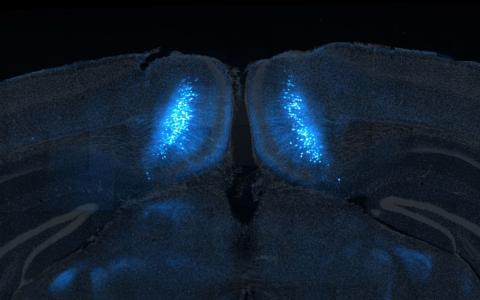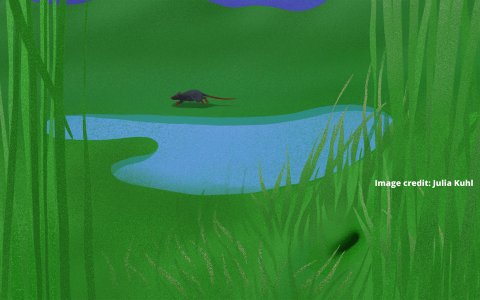Survival of the fittest often means survival of the fastest. But fastest doesn’t necessarily mean the fastest moving. It might mean the fastest thinking. When faced with the approach of a powerful predator, for instance, a quick brain can be just as important as quick feet.
After all, it is the brain that tells the feet what to do — when to move, in what direction, how fast and for how long. And various additional mental acrobatics are needed to evade an attacker and avoid being eaten. A would-be meal’s brain must decide whether to run or freeze, outrun or outwit, whether to keep going or find a place to hide. It also helps if the brain remembers where the best hiding spots are and recalls past encounters with similar predators.
All in all, a complex network of brain circuitry must be engaged, and neural commands executed efficiently, to avert a predatory threat. And scientists have spent a lot of mental effort themselves trying to figure out how the brains of prey enact their successful escape strategies. Studies in animals as diverse as mice and crabs, fruit flies and cockroaches are discovering the complex neural activity — in both the primitive parts of the brain and in more cognitively advanced regions — that underlies the physical behavior guiding escape from danger and the search for safety. Lessons learned from such studies might not only illuminate the neurobiology of escape, but also provide insights into how evolution has shaped other brain-controlled behaviors.
This research “highlights an aspect of neuroscience that is really gaining traction these days,” says Gina G. Turrigiano of Brandeis University, past president of the Society for Neuroscience. “And that is the idea of using ethological behaviors — behaviors that really matter for the biology of the animal that’s being studied — to unravel brain function.”
Think fast
Escape behavior offers useful insight into the brain’s inner workings because it engages nervous system networks that originated in the early days of evolution. “From the moment there was life, there were species predating on each other and therefore strong evolutionary pressure for evolving behaviors to avoid predators,” says neuroscientist Tiago Branco of University College London.
Not all such behaviors involve running away, Branco notes. Rather than running you might jump or swim. Or you might freeze or play dead. “Because of the great diversity of species and their habitats and their predators, there are many different ways of escaping them,” Branco said in November in San Diego at the 2022 meeting of the Society for Neuroscience.
Of course, sometimes an animal might choose fight over flight. But unless you’re the king of the jungle (or perhaps a roadrunner much smarter than any wily predatory coyote), fighting might be foolish. When an animal is the prey, escape is typically its best choice. And it needs to choose fast.
“If it decides to escape it should make this escape as quickly and accurately as possible,” Branco points out. “And then it should also terminate it as soon as possible because escape is a very costly affair. It costs energy and it also costs missed opportunities.”
Escape strategy begins with detecting the possible presence of a predator. Detection should be rapid and instinctive — an instant response to a sight, sound or smell. Then, after sensing the threat, an animal’s brain has to quickly implement complex algorithms giving muscles instructions about how to move and where to move to. It’s a complicated decision-making process, involving multiple considerations, including the threat’s proximity, environmental circumstances and the prey’s own condition.
First among things to consider is the immediacy of the threat. Sometimes there’s time to determine the predator’s identity before taking evasive action. But often the response must be quicker. A “looming” threat — in which a blobby image on the retina grows rapidly larger — allows no time to lose. Escape should be initiated before the prey knows who the predator is.
“It doesn’t matter if it is an owl or a car or an object,” says Branco. “If it’s coming fast in your direction you really want to get out of there and think of what it might be afterwards.”
Even the simplest animals have evolved rapid escape actions when detecting an immediate threat. Fruit flies, for instance, adjust the position of their legs in order to jump away from a threatening stimulus. Cockroaches scurry rapidly away in a direction roughly opposite that of an approaching predator — but not always precisely the same direction, choosing from three or four possible paths. If the roaches always chose the exact same angle of escape, predators might devise a counterstrategy, Branco points out.
In more complex animals, elaborate brain circuitry has evolved to detect threats and communicate a threat’s presence to the motor systems that direct the muscles to get moving. For a looming stimulus, a nucleus of nerve cells in the midbrain called the optic tectum has served as the prime threat detector since the early days of vertebrate evolution. (In mammals, the analogous brain structure is known as the superior colliculus.) Cells in the retina detecting a rapidly expanding object send signals to the optic tectum or superior colliculus, alerting the brain to an imminent collision. In turn, the tectum/colliculus signals nerve cells to activate muscles. In mammals, those nerve cells reside in the periaqueductal gray or PAG, a structure in the brain stem.
In mice, neural connections between the superior colliculus and PAG are essential for linking threat detection to escape behavior, research has shown. Presenting a large, dark, circular shadow in an otherwise empty arena induces a mouse to immediately flee toward refuge in a small shelter on the arena’s edge. But if the synapses connecting the superior colliculus to the PAG are cut, mice freeze rather than fleeing when encountering a looming threat, Branco said at the neuroscience meeting.






